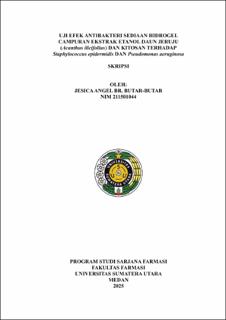| dc.description.abstract | Background: Staphylococcus epidermidis and Pseudomonas aeruginosa are common bacteria responsible for skin infections. Jeruju leaves (Acanthus ilicifolius) contain antibacterial compounds such as alkaloids, flavonoids, and tannins. In this study, ethanol extract of jeruju leaves was combined with chitosan, which serves both as a gel base and a natural antibacterial agent, and formulated into a hydrogel dosage form to create an optimal wound environment and to enhance the comfort and effectiveness of local wound therapy. Objective: To formulate stable hydrogel preparations containing 2% chitosan and 2.5%, 5%, and 10% ethanol extract of jeruju leaves, and to evaluate their antibacterial activity against S. epidermidis and P. aeruginosa. Methods: Phytochemical screening and characterization of jeruju leaf simplicia were carried out. The leaves were extracted using the maceration method with 96% ethanol. The antibacterial activity of the extract was tested using the well diffusion method. Hydrogel formulations with 2% chitosan and various extract concentrations—F1 (2.5%), F2 (5%), and F3 (10%)—were prepared. The hydrogel was evaluated for 12-week stability, homogeneity, pH, viscosity, and antibacterial activity against the test bacteria. Results: The ethanol extract contained alkaloids, flavonoids, glycosides, tannins, and steroids/triterpenoids. The minimum inhibitory concentration (MIC) of the extract was 2%, with inhibition zones of 7.33 ± 0.12 mm against S. epidermidis and 7.20 ± 0.10 mm against P. aeruginosa. All hydrogel formulations remained stable for 12 weeks, were homogeneous, had pH values ranging from 4.63 to 5.56, and viscosities between 2355–2730 cP. F1 exhibited moderate antibacterial activity, while F2 and F3 showed strong activity. One-way ANOVA indicated that chitosan significantly enhanced the hydrogel’s antibacterial effect. Conclusion: Formulations F1 (2.5%), F2 (5%), and F3 (10%) demonstrated strong antibacterial effectiveness. The presence of chitosan significantly increased the antibacterial activity of the hydrogel. | en_US |


